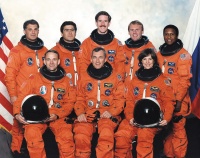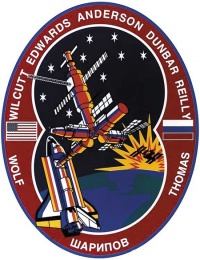STS-89
From The Space Library
 | |
| Organization | NASA-Office of Space Flight (United States) |
|---|---|
| Mission type | Human Crew,Microgravity |
| Launch date | January 23, 1998 |
| Launch vehicle | Space Shuttle |
| Launch site | Cape Canaveral, United States |
| COSPAR ID | 1998-003A |
| Inclination | 51.6 degrees |
| Experiments | Here |
| Alternate Names | 25143 |
| Additional Information | Here |
| Data Collection | Here |
| Payload Mass Up | 9951.81 kg |
| Payload Mass Down | 8876.82 kg |
| Orbiter | Endeavour |
| Lift Off Mass | 2,051,185.45 kg |
| Orbiter Weight at Liftoff | 114,405.45 kg |
| Orbiter Weight at Landing | 98,291.36 kg |
| Landed | Concrete runway 15 at Kennedy Space Center, Fla. |
| Orbits of Earth | 139 |
| Orbital Altitude | 213 nautical miles (245 statute miles) |
Contents |
[edit] Crew
- Commander: Terrence W. Wilcutt
- Pilot: Joe Frank Edwards Jr.
- Payload Commander: Bonnie J. Dunbar
- Mission Specialist 1: James F. Reilly II
- Mission Specialist 2: Michael P. Anderson
- Mission Specialist 3: Salizhan Shakirovich Sharipov, Russian Space Agency
- Mission Specialist 4: Andrew S.W. Thomas
- Mission Specialist 5: David A. Wolf
- Payload Specialist 1:
- Payload Specialist 2:
ISS/Mir Crew Transport
[edit] Mission
STS 89 was a US Shuttle launch intended to reach and dock with the MIR space station to deliver a new American astronaut for endurance and experience in MIR, and to bring back an earlier astronaut after his four months of stay. It also carried 1,500 kg of supplies and docked at 20:14 UT on January 24. STS 89 also carried resources for some microgravity experiments with names like Closed Equilibrated Biological Aquatic System (CEBAS), Microgravity Plant Nutrient Experiment (MPNE), and Interferometer Protein Crystal Growth (IPCG). It unlocked from MIR at 16:56 UT on January 29. More information can be found at: http://shuttle.nasa.gov/sts-89/orbit/payloads
[edit] EVA
[edit] Payload
SPACEHAB 08 double module/Mir 08; transfer tunnel; transfer tunnel extension; orbiter docking system; Getaway Specials 093, 141, 145, and 432; Phase 1 requirements (Shuttle-Mir Mission 08 middeck science, mission support equipment and risk mitigation experiments); cosmic radiation effects and activation monitor (CREAM); Shuttle Ionospheric Modification With Pulsed Local Exhaust (SIMPLEX) payload of opportunity; EarthKAM (also known as KidSat); microgravity plant nutrient experiment (MPNE); human performance (HP) experiment; closed equilibrated biological aquatic system (CEBAS)
[edit] Books about the Space Shuttle Program
Buy This Book Click here |
Buy This Book here |
Buy This Book Click here |
Buy This Book Click here |





